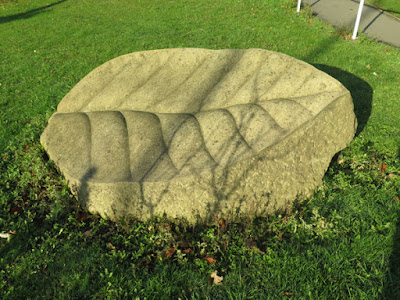 |
| A leaf sculpture at the junction of City Road and Windy House Lane |
With the good weather of autumn 2018 finally coming to an end in November, except for a few short walks in Sheffield city centre to look for some public art and sculpture, it was nearly a month since visiting the Upper Don Valley and Sheffield City Hall that I set off to explore some more of Sheffield’s geology and geomorphology again.
 |
| Geology of Britain Viewer 3D map of the area around City Road |
Coinciding with a weekend where the venues of Yorkshire Art Space were open to the general public, I took a walk from Manor Top to Manor Lodge via the City Road Cemetery, which coincided with the outcrop of the Parkgate Rock. This sandstone forms very prominent topography to the south of Sheffield, including Skye Edge, and although folded to some extent along its strike, it follows the typical NW–SE direction found in the region and is not generally affected by the Don Monocline.
 |
| Sculpture by Tom Clark at Manor Top Library |
Taking the tram to Manor Top, where I wanted to have a quick look at the architecture of the public library here, I was pleasantly surprised to discover that the area in front of the library had been landscaped and contained at its centre, a sculpture by Tom Clark – one of several produced with Thomas Kenrick and Ben Leach, in Crosland Hill stone, for the City Road Project in 2009.
 |
| Leaf sculptures at the junction of City Road and Windy House Lane |
Walking down City Road, three large leaf sculptures by the same artists occupy a small green space at the junction of Windy House Lane and a little further down - on the opposite side of the road – various other sculptures occupy a small patch of waste ground that, unfortunately, is full of litter and appears neglected.
 |
| Stone way markers and sculpture on City Road |
Carrying on further down the hill, the entrance to Manor Fields Park caught my eye, with sections of rock faced sandstone walling set at various angles - which seems very appropriate in a region where the strata has been distorted by faults and folding.
 |
| Sandstone walling to the City Road entrance to Manor Fields Park |
The various walls are terminated on the City Road frontage by four large rough blocks of blue hearted Ancaster Weatherbed limestone, whose drill marks record the extraction from the quarry face using the traditional technique of plug and feathers.
 |
| Rough blocks of Ancaster Weatherbed limestone at Manor Fields Park |
Having once spent a few months cutting this stone, along with White Mansfield and Chilmark stone, I was particularly interested to see that these blocks also have some pink colouration, which appeared only very occasionally on my saw bench.
 |
| Landscaping with Carboniferous sandstone at Manor Fields Park |
Taking a quick look at the park, which once formed a part of the mediaeval deer park that was centred on Manor Lodge, I was interested to see that it has been landscaped with Carboniferous sandstone – using dy stone walling, various boulders and large slabs of stone that are constructed in the form of a tor.
 |
| A tor like structure at Manor Fields Park |
No comments:
Post a Comment